Abstract
This study encompassed 64 participants with symptoms of low back pain, 33 in McKenzie group and 31 in Brunkow group. Patients attended exercise program daily and they were asked to do the same exercise at home -five times a day in series of 5 to 10 repetition each time, depending of stage of disease and pain intensity. All patients were assessed for the spinal motion, before and after the treatment.
All parameters for spinal movements showed improvement after exercising McKenzie program for lower back pain with a significant difference of p<0.01 for all motions. Also, in Brunkow group, all of the parameters showed statistically significant improvement at the end of treatment in relation to pre-treatment values, with significant difference of p<0.01 for all motions.
Statistically comparison between McKenzie and Brunkow difference in score at the end of the treatment showed statistically significant improvement in McKenzie group, for extension, right and left side flexion, while flexion score didn’t show statistically significant difference.
McKenzie exercises seemed to be more effective than Brunkow exercises for improvement in spinal motion. Both, McKenzie and Brunkow exercises can be used for spinal mobility improvement in patients with lower back pain, but is preferable to use McKenzie exercises first, to decrease the pain and increase spinal mobility, and then Brunkow exercises to strengthen the paravertebral muscles.
Keywords: McKenzie, Brunkow, exercises, dynamic, isometric, spinal mobility
INTRODUCTION
Low back pain affects 60-80 % of adults at some time of their lives, and 50% suffer from the back pain within given year. Back symptoms are among the 10 leading reasons for patient visits to emergency rooms, hospital outpatient departments and physicians’ offices. (1, 2)
Therapeutic approaches to this problem are different and very often controversial. In general, physiotherapy treatments can be sorted in “passive” treatments, such as thermo- and cryo-procedures, manipulation, massage, orthotic devices, traction and electrotherapy, and “active” treatments like kinesitherapy procedures.
There are different types of exercises for back pain, such as flexion exercises, extension exercises, or some specific exercises that are combination of these two types. Decision which type of exercises can be applied is very individual, depends of physician’s approach and there is no prescription which one is the most appropriate for each patient. (3, 4, 5, 6, 7, 8, 9, 10, 11, 12)
Exercise is typically aimed at strengthening back extensors or flexors and increasing back flexibility to reduce injury risk, improving mood and pain perception to reduce the impact of injury. (13, 14, 15, 16, 17)
One of specific exercises programs for low back pain can be McKenzie approach (18) that consists of six exercises performing in certain positions (laying in prone position, standing, laying in supine position and sitting), which gradually increase the pressure on the vertebra. These exercises can be called self-manipulation exercises and they have to be done in small sessions but frequently, during the day. During this exercise program postural correction is needed as well as observation of all changes in pain intensity and location. Number of sessions and daily frequency depended of stage of disease and pain
Brunkow exercises (23) can be called “pushing exercises” and they can be done in all starting positions. Main action is isometric contraction, which started by movements of feet and/or hands, and transferring through kinetic chain to paravertebral muscles. They are starting with dynamic contraction of hands and feet with “punctum fixum” on the wrist or/and heal. Dynamic contraction from the beginning leads to isometric contraction of the group of muscles, which has to be included in the exercise. Starting positions determinates the group of muscles to be trained.
These completely different types of exercises are in daily use for patients with lower back pain in Physical Medicine and Rehabilitation Centres and the purpose of this study was to compare the effects of McKenzie and Brunkow exercises on spinal motion improvement.
METHODS
Participants
Sixty-eight patients with symptoms of low back pain were included in study, which was approved by the Ethics Committee of the Sarajevo University Faculty of Medicine. Patients were recruited from Physical Medicine and Rehabilitation outpatient Clinic in Community Based Rehabilitation Centres in Sarajevo and from University Clinical Centre Sarajevo - Institute for Physical Medicine and Rehabilitation. Subjects were referred for physiotherapy treatment from Primary Health Care physicians or from specialist Clinic (orthopaedic, traumatology, neurology etc). Patients were included in study if they had symptoms of lower back pain, without any motor or sphincter deficit. Physiatrist and physiotherapist gave instructions for exercises and provided supervision of the patients.
Of this group 34 individuals (10 men, 24 women) performed McKenzie program and 34 individuals (13 men, 21 women) Brunkow exercise program. The mean age was 50 years (SD 10.8 years) for McKenzie group and 47 years (SD 13.8 years) for Brunkow group.
Professionals who had minimal training in McKenzie and Brunkow method gave instructions for exercises and made supervision of the patients.
One patient from McKenzie group and 3 patients from Brunkow group didn’t complete the treatment, thus 33 patients from McKenzie group and 31 patient from Brunkow group enrolled into the statistical analysis, total of 64 patients.
Measures
All patients were assessed before and after the treatment. Spinal range of motions were measured using centimetre and measuring a distance between top of the third hand finger and floor while patient were asked to move forward, backward and on right and left lateral side.
Exercise therapy
McKenzie and Brunkow exercises were performed individually to the need and possibility of each patient.
Patients attended exercise program daily, under supervision of physiatrist and physiotherapist in the Clinic for Physiotherapy and Rehabilitation, and they were asked to do the same exercise program at home - five times a day in series of 5 to 10 repetition each time, depending of stage of disease and pain intensity.
Type of exercises and number of repetitions in each session were created individually for each patient. All exercises were followed by correction of body posture.
Starting positions for Brunkow exercise program were the same as for McKenzie program, gradually increasing pressure on vertebra (prone position, standing, supine position and sitting).
Statistics
Results were expressed as mean +/- SD. Differences in-group means were examined by Student t-test.
RESULTS
A total of 64 patients participated in this study. In McKenzie group there were 29% male and 71% female participants, and in Brunkow group exercised 38% male and 62% female patients. (Figure 1)
Figure 1.
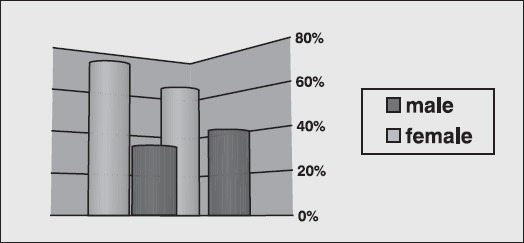
Gender structure of participants who involved in McKenzie and Brunkow program for low back pain
Mean age of patients who exercised McKenzie program was 50 years (+/- 10.8 years) and for patients in Brunkow group was 42 years (+/- 13.8 years). Brunkow group was significantly younger with t-test 2.988 and significant difference p<0.01.
In Mckenzie group 23% of patients experienced first symptoms of lower back pain in the year of assessment, 27% has experienced a pain for 4 years, 23% 10 years and 27% more than 10 years.
In Brunkow group 41% of patients suffered the pain for less than one year, 15% of patients for 4 years, 20% 10 years, 24% more than 10 years. (Figure 2)
Figure 2.
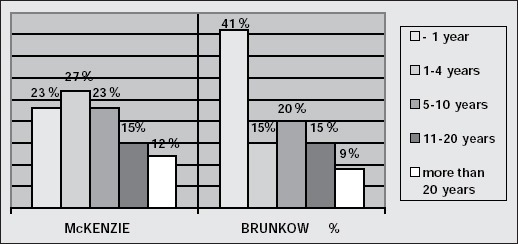
First symptoms of low back pain in participants in the study
According to Quebec Task Force of Spinal Disorders (24) all patients were grouped in 3 groups: acute stage of disease -pain less than 7 days, subacute stage - pain from 8 days to 7 weeks and chronic stage - pain more than 7 weeks. There were 15% of participants in acute pain, 55.5% in subacute and 29.5% in chronic pain in McKenzie group and 9% in acute stage, 50% in subacute and 41% in chronic stage in Brunkow group. (Table 2) There was no statistically significant difference in stage of pain between McKenzie and Brunkow group before the treatment - Hi 2 = 1. 278
Table 1.
Mean age of patients in McKenzie and Brunkow group

Table 2.
Stage of pain in McKenzie and Brunkow group of patients.

In McKenzie group, patients received a mean of 15.5 days of treatments with standard deviation of 8.95.
In Brunkow group, patients received a mean of 14.9 days of treatments with standard deviation of 8.96.
One patient didn’t complete the treatment in McKenzie and 3 patients in Brunkow group, thus 33 McKenzie patients and 31 Brunkow enrolled into the statistical analysis.
Data analysis
Table 3 shows mobility scores for McKenzie group from four movements, from the neutral position to the maximum active motion in the sagittal (flexion/extension) and coronal (left/right) phases, at 2 evaluation times.
Table 3.
Spinal mobility before and after McKenzie exercise program in patients with low back pain.
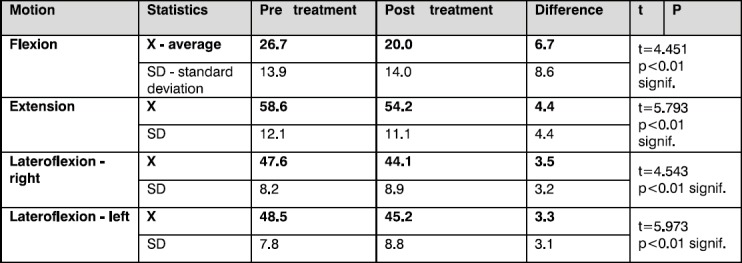
All parameters for spinal movement showed improvement after exercising McKenzie program for lower back pain. Difference in measurements before and after McKenzie exercise program showed that flexion increased for 6.7 cm in average, extension for 4.4 cm; right side flexion for 3.5cm and left side flexion for 3.3 cm in average. All of these parameters showed statistically significant improvement at the end of treatment in relations to pre-treatment values, with significant difference of p<0.01.
In second group of patients with lower back pain, who were exercising Brunkow program, all parameters for spinal movement also showed significant improvement at the end of the treatment (Table 4)
Difference in measurements before and after treatment showed that flexion increased for 3.4 cm in average, extension for 1.7 cm; right side flexion for 2.0 cm and left side flexion for 2.2 cm in average. All of these parameters showed statistically significant improvement at the end of treatment in relations to pretreatment values, with significant difference of p<0.01. Comparing the results in spinal movement measurements, between McKenzie and Brunkow group, it is evident that McKenzie group had better mobility score for all parameters. (Table 5)
Table 5.
Spinal mobility in patients with low back pain after McKenzie and Brunkow exercise program.
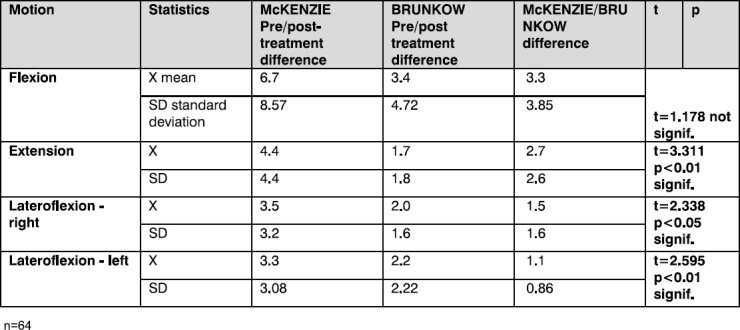
Flexion has better score in McKenzie group for 3.3 cm, extension for 2.7 cm; right side flexion for 1.5 cm and left side flexion for 1.1 cm in average. Statistically comparison between McKenzie and Brunkow difference in score at the end of the treatment showed statistically significant improvement in McKenzie group, for extension, right and left side flexion, while flexion score didn’t show statistically significant difference.
Comparing pre-treatment and post-treatment score for both group of patients, it was found that among 33 patients who did McKenzie exercise program for low back pain 6 % of patients didn’t have improvement in spinal flexion, 9 % in extension, 9 % is right side flexion and 12 % in left side flexion. In Brunkow group 13% of patients didn’t improve in flexion score, 9% in extension, 9% in right side flexion and 23% in left-side flexion. (Figure 3)
Figure 3.
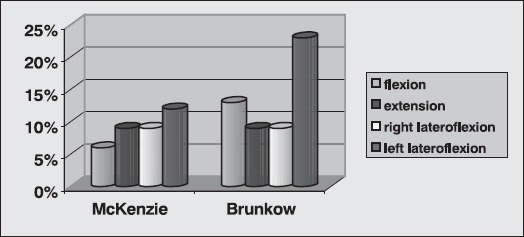
Patients without improvement in spinal mobility after exercise program
Results in this study showed that the majority of patients in McKenzie group improved from pre-treatment to post-treatment score, comparing with number of patients in Brunkow group.
Statistical analysis showed that both group of patients had statistically significant improvement in spinal mobility after treatment in comparison with pre-treatment values. But, comparing inter group values, than McKenzie group had significantly better results for all spinal mobility parameters except spinal flexion. (Table 6)
Table 6.
Significam difference in spinal mobility after exercise program for lower back pain.

DISCUSSION
This study investigated the use of McKenzie and Brunkow exercises for low back pain and it’s influence on spinal mobility.
Kinesitherapy treatment is an “active” physiotherapy treatment that can be applied to the patients with lower back pain.
Decision which type of exercises can be used is very individual, depends of physician’s approach and there is no define prescription which type of exercises is indicate for which patients and when. (3-12).
A lot of researches compared different types of exercises (12, 25, 26, 27), but there is no evidence that any of it compare effects of McKenzie and Brunkow exercises on spinal mobility. (18, 23)
These two completely different types of exercises are in daily use in Physiotherapy and Rehabilitation Centres, so our interest was to compare them and see what are their effects on improving spinal movements.
McKenzie exercises are dynamic exercises (extension -flexion type) while Brunkow exercises started as dynamic, but finishing with isometric (static) contraction of par-avertebral muscles.
Patients attended exercise program daily, under supervision of physiatrist and physiotherapist in the Clinic for Physiotherapy and Rehabilitation, and they were asked to do the same exercise program at home - five times a day in series of 5 to 10 repetition each time, depending of stage of disease and pain intensity.
Type of exercises and number of repetitions were created individually for each patient.
All patients were assessed before and after the treatment and their spinal movements are measured (flexion -extension - right and left side flexion).
There were no significant differences between the groups of patients with a low back pain that participate in this study. In both groups majority of participants were females, aged between 42 and 50 years, first pain episode in last 5 years, last pain episode one month before treatment and treatment period of 15 days. There was no statistically significant difference in stage of pain between McKenzie and Brunkow group before the treatment.
All patients showed some evidence of restricted ROM before the treatment, mostly because of pain limitation. Spinal mobility measurements were used as a predictor for functional evaluation and pain reduction (more pain relief, better functional results), so this functional test functioned as a pain provocation test.
An improvement in all parameters of spinal motion was seen in both groups, either they exercised McKenzie or Brunkow program, (comparing pre treatment and post treatment measurements), although there are two completely different types of exercises. Reduction of the pain after training has also been reported in some trials involving the low back, cervical pain etc. (28) Activities related pain can be decreased by increasing endorphins that occurs after training. Strong muscle contractions activate muscles’ ergo-receptors (stretch receptors). (29) The afferents from the receptors cause endogenous opioids to be released and also cause the release of beta-endorphin from pituitary. These secretions may cause both - peripheral and central pain to be blocked. (30)
Low back pain is frequently associated with persistent joints stiffness from capsular, ligamentous, or paraarticular muscle and tendon contracture, and that is another reason for limited spinal mobility in our participants. Comparison between spinal mobility measurements in both groups of patients after exercise program showed that McKenzie group showed better results in all parameters in relation with Brunkow group. Statistical analysis, also, showed better values for all parameters in McKenzie group, except for spinal flexion. This can be explained by a nature and technique of McKenzie exercises, which are at the beginning of treatment, preferable extension type and later as pain decreases, continues with flexion movements. Terminal extension and flexion in the same time would stretch some spinal structures while strengthening of the others, and on that way increasing spinal flexibility at all. Through stretching and active physical training, some pain can be relieved as stiffness improves. (31).
On the opposite side, Brunkow exercises are isometric exercises, which can slightly decrease the pain, but mostly can be used for strengthening the spinal muscles. Assisting patients to maximize mobility before they start a strength-training program is a key principle of functional restoration (31, 32, 33).
CONCLUSION
McKenzie exercises seemed to be better than Brunkow for improvement of the spinal motion.
Spinal mobility in patients with lower back pain, can improve by performing exercises for lower back pain either McKenzie or Brunkow program.
For better functional restoration, patients with lower back pain first have to increase spinal mobility and then to start with strength training program.
Both, McKenzie and Brunkow exercises can be used for spinal mobility improvement in patients with lower back pain, but is preferable to use first McKenzie exercises to decrease the pain and increase spinal mobility, and then Brunkow exercises to strengthen the paravertebral muscles.
REFERENCES
- 1.Rockville. Acute low back problems in adults. US Department of Health and Human Services. Public Health Service, AHCPR; 1994 160, Clinical practice guideline; No 14 [Google Scholar]
- 2.Randall B. Physical medicine and Rehabilitation. Vol. 39. W.B. Saunders; 1996. pp. 813–840. [Google Scholar]
- 3.Faas A. Exercises: which ones are worth trying, for which patients, and when? Spine. 1996;21(24):2874–8. doi: 10.1097/00007632-199612150-00016. [DOI] [PubMed] [Google Scholar]
- 4.Faas A, van Ejik JT, Chavannes AW. A randomised trial of exercise therapy in patients with acut6e low back pain. Efficacy on sickness absence. Spine. 1995;20(8):941–7. doi: 10.1097/00007632-199504150-00012. [DOI] [PubMed] [Google Scholar]
- 5.Szmelskyj A. Do complementary therapies stimulate the body’s natural painkilling medications?A literature review. Complementary - Ther - Med. 1998;1:36–41. [Google Scholar]
- 6.Keen S, Dowell AC, Hurst K. Klaber. Individuals with low back pain: how do they view physical activity? Fam Pract. 1999;16(1):39–45. doi: 10.1093/fampra/16.1.39. [DOI] [PubMed] [Google Scholar]
- 7.Kampello M, Nordin M, Weiser S. Physical exercise and low back pain. Scand J Med Sci Sports. 1996;6(2):63–72. doi: 10.1111/j.1600-0838.1996.tb00073.x. [DOI] [PubMed] [Google Scholar]
- 8.van Tulder MW, Koes BW, Boulter LM. Conservative treatment of acute and chronic non-specific low back pain. A systematic review of randomised controlled trials of the most common interventions. Spine. 1997;22(18):2128–56. doi: 10.1097/00007632-199709150-00012. [DOI] [PubMed] [Google Scholar]
- 9.Schneiders AG, Zusman M, Singer KP. Exercise therapy compliance in acute low back pain patients. Manual Therapy. 1998;3(3):147–52. [Google Scholar]
- 10.Jette DU, Jette Am. Physical therapy and health outcomes in patients with spinal impairment. Phys-Ther. 1996;76(9):930–45. doi: 10.1093/ptj/76.9.930. [DOI] [PubMed] [Google Scholar]
- 11.Dillingham TR, Delateur BJ. Exercise for low back pain: what really works? Phys - Med - Rehabil - state -Art - Rev. 1995;9(3):697–708. [Google Scholar]
- 12.Dettori JR, Bullock SH, Sutlive TG, Franklin RJ. The effects of spinal flexion and extension exercises and their associated postures in patients with acute low back pain. Spine. 1995;20(21):2303–12. doi: 10.1097/00007632-199511000-00008. [DOI] [PubMed] [Google Scholar]
- 13.U.S. Preventive services. Task Force Guide to clinical Preventive Services. 2nd Edition. Washington DC: US Department of Health and Human Services Office of Disease Prevention and Health Promotion; 1996. [Google Scholar]
- 14.Seferlis T, Nemeth G, Carlsson AM. Conservative treatment in patients sick-listed for acute low-back pain: a prospective randomised study with 12 months follow-up. Eur Spine J. 1998;7(6):461–70. doi: 10.1007/s005860050109. [DOI] [PMC free article] [PubMed] [Google Scholar]
- 15.Mielenz TJ, Carey TS, Dyrek DA, Harris BA. Physical therapy utilisation by patients with acute low back pain. Phys Ther. 1997;77(10):1040–51. doi: 10.1093/ptj/77.10.1040. [DOI] [PubMed] [Google Scholar]
- 16.Casazza BA, Young JL. The role of exercise in the prevention and management of acute low back pain. Occup Med. 1998;13(1):47–60. [PubMed] [Google Scholar]
- 17.Jette D, Jette A. Physical therapy and health outcomes in patient with spinal impairments. Phys ther. 1996;76(9):930–945. doi: 10.1093/ptj/76.9.930. [DOI] [PubMed] [Google Scholar]
- 18.McKenzie . Treat your own back. New Zeeland: Spinal publications LTD; [Google Scholar]
- 19.Donelson R. The McKenzie approach to evaluating and treating low back pain. Orthopedic review. 1990;XIX(8) [PubMed] [Google Scholar]
- 20.Philadelphia panel evidence-based clinical practice guidelines on selected rehabilitation interventions for low back pain. Physical Therapy. 2001;81:1641–1674. [PubMed] [Google Scholar]
- 21.Holdom A. The use of McKenzie approach to treat back pain. Br J Ther&Rehab. 1996;3(1):7–10. [Google Scholar]
- 22.Hyman MH, Jacob G, Lin K, Mooney V. Primary care update: brief summaries for clinic. Mechanical diagnosis and therapy: the McKenzie approach to spinal complaints. Consultant. 1999;39(7):2115–6. Overview. [Google Scholar]
- 23.Brunkow R, Stemmfuhrungnach R. Brunkow Ferdinand Enke Verlag Stuttgart. 1978;1-9(14-29):47–92. [Google Scholar]
- 24.Wheeler A. Diagnosis and management of low back pain and sciatica. American Family Physician. 1995;54:1333–1341. [PubMed] [Google Scholar]
- 25.Stankovi} R, Johnell O. Conservative treatments of acute low back pain. A 5-year follow-up study of two methods of treatment. Spine. 1995;15(20(4)):469–472. doi: 10.1097/00007632-199502001-00010. [DOI] [PubMed] [Google Scholar]
- 26.Fernando CK. Conservative treatment of acute low-back pain, a prospective randomised trial: McKenzie method of treatment versus patient education in mini-back school. Spine. 1991;16(3):391. [PubMed] [Google Scholar]
- 27.White AH, Anderson RT. Conservative care of low back pain. Vol. 97119. Baltimore: Williams and Wilkins; 1991. pp. 159–168. [Google Scholar]
- 28.Highland TR, Dreisinger TE, Vie LL. Changes in isometric strength and range of motion of isolated cervical spine after eight weeks of clinical rehabilitation. Spine. 1992;17(6 Suppl):77–82. doi: 10.1097/00007632-199206001-00003. [DOI] [PubMed] [Google Scholar]
- 29.Thoren P, Floras JS, Hoffmann P. Endorphins and exercise: physiological mechanism and clinical implications. Med Sci Sports Exerc. 1990;22:417–428. [PubMed] [Google Scholar]
- 30.Hagberg M, Harms-Ringdahl K. Rehabilitation of neck - shoulder pain in women industrial workers: A randomised trial comparing isometric shoulder endurance training with isometric shoulder strength training. Arch-Physic- Med- Rehab. 2000;81(8):1051–1058. doi: 10.1053/apmr.2000.7582. [DOI] [PubMed] [Google Scholar]
- 31.Mayer T, Robinson R. Lumbar segmental rigidity: Can its identification with facet injections and stretching exercises be useful. Arch-Physic- Med- Rehab. 2000;81(9):1143–1150. doi: 10.1053/apmr.2000.9170. [DOI] [PubMed] [Google Scholar]
- 32.Mayer T, Mooney V, Getchel R. Contemporary conservative care for spinal disorders: concepts, diagnosis and treatment. Philadelphia: Lea&Febiger; 1991. [Google Scholar]
- 33.Mayer T, Polatin P, Smith B. Contemporary concepts in spine care. Spine Rehabilitation: secondary and tertiary non-operative care. Spine. 1995;20:2060–2066. [PubMed] [Google Scholar]


